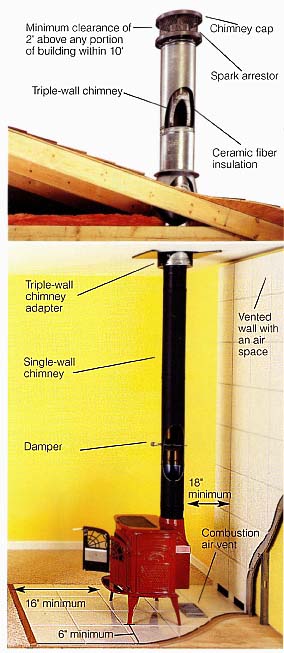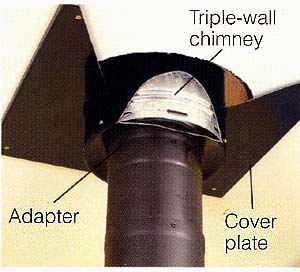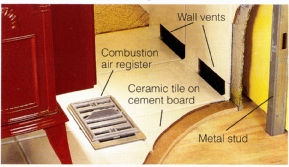A freestanding wood-burning stove can provide much of the ambience of a traditional masonry fireplace and do so with efficiency ratings as high as 75 percent com pared with a fireplace’s low or even negative efficiencies. Some stoves can burn with their doors open, but all provide the most heat when closed and properly vented. Part of the key to their efficient heat transfer is the amount of exposed surface area; lined with firebrick and built of heavy steel plate or cast iron, a wood stove’s firebox radiates heat in all directions, warming sur rounding objects and surfaces. For safety, minimum clearances for combustible materials are mandated by codes and manufacturers (see image at right). Relative to a fireplace, a woodstove offers much more control over combustion air intake and burn rates, but for peak efficiency and lower emissions, the smoke- exhaust temperature should stay between 300°F and 400°F (150°C and 200°C). For this reason, don’t buy more stove capacity than the space requires. It’s better to install a smaller stove and burn it hot rather than burn a too-large stove slowly to avoid overheating the room. Also, don’t slow-burn a stove to make the fire last through the night; instead, install a masonry surround with enough thermal mass to store and release the heat after the fire burns out. You’ll get the most efficiency by burning seasoned hardwood or manufactured pellets made from com pressed sawdust. Never burn unseasoned “green” wood, railroad ties, pressure-treated lumber or plastics in a woodstove. |
 |



Roof ComponentsWhere the stove chimney exits the roof, an adjustable support bracket positions it to maintain a 2-in. (5-cm) clearance from combustibles. Flashings and caulk keep rainfall at bay. |

Ceiling ComponentsEntering the ceiling, the single-wall stove pipe must be fitted with an adapter to connect to a triple-wall chimney or other approved insulated chimney. Cover plates can include decorative trim or a simple flange to cover the clearance hole in the ceiling.
|

Floor and Wall ComponentsSurfaces below and behind the stove should be noncombustible materials, such as ceramic tile or masonry. A floor register provides outside combustion air. The wall surface features a vented air space for keeping the wall cool. |
Cleaner Burning WoodstovesOnly about half the potential energy from a fire comes from the wood; the rest lies in the heated gases we call smoke. Newer wood stoves feature a catalytic combustion similar to the devices used for reducing emissions in automobile exhaust, that re-burns the smoke to extract heat energy and reduce airborne pollutants. Often required by law, many of these stoves produce only 2 to 5 grams of smoke per hour—a 95-percent reduction. |
